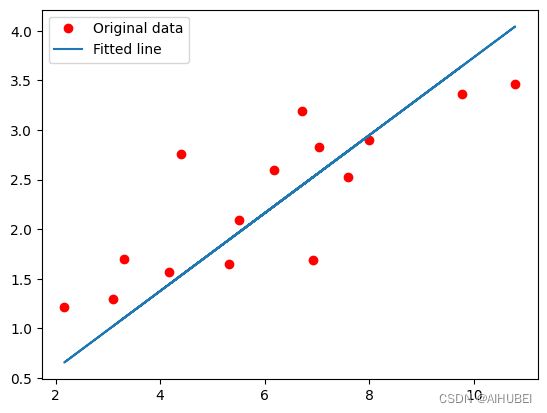使用Pytorch实现线性回归
import torch
import torch.nn as nn
import numpy as np
import matplotlib.pyplot as plt
input_size = 1
output_size = 1
num_epochs = 60
learning_rate = 0.001
x_train = np.array([[3.3], [4.4], [5.5], [6.71], [6.93], [4.168],
[9.779], [6.182], [7.59], [2.167], [7.042],
[10.791], [5.313], [7.997], [3.1]], dtype=np.float32)
y_train = np.array([[1.7], [2.76], [2.09], [3.19], [1.694], [1.573],
[3.366], [2.596], [2.53], [1.221], [2.827],
[3.465], [1.65], [2.904], [1.3]], dtype=np.float32)
print(x_train.shape, y_train.shape)
(15, 1) (15, 1)
model = nn.Linear(input_size, output_size)
criterion = nn.MSELoss()
optimizer = torch.optim.SGD(model.parameters(), lr=learning_rate, )
for epoch in range(num_epochs):
inputs = torch.from_numpy(x_train)
targets = torch.from_numpy(y_train)
outputs = model(inputs)
loss = criterion(outputs, targets)
optimizer.zero_grad()
loss.backward()
optimizer.step()
if (epoch+1) % 5 == 0:
print('Epoch [{}/{}], loss: {:.4f}'.format(epoch+1, num_epochs, loss.item()))
predicted = model(torch.from_numpy(x_train)).detach().numpy()
plt.plot(x_train, y_train, 'ro', label='Original data')
plt.plot(x_train, predicted, label='Fitted line')
plt.legend()
plt.show()
Epoch [5/60], loss: 7.1598
Epoch [10/60], loss: 3.0717
Epoch [15/60], loss: 1.4154
Epoch [20/60], loss: 0.7443
Epoch [25/60], loss: 0.4722
Epoch [30/60], loss: 0.3618
Epoch [35/60], loss: 0.3169
Epoch [40/60], loss: 0.2985
Epoch [45/60], loss: 0.2909
Epoch [50/60], loss: 0.2876
Epoch [55/60], loss: 0.2861
Epoch [60/60], loss: 0.2853

torch.save(model.state_dict(), 'model_param.ckpt')
torch.save(model, 'model.ckpt')
